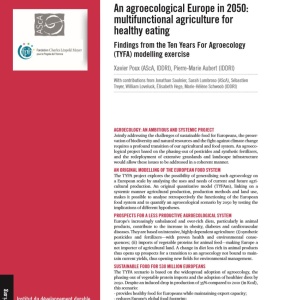
This report, originally published in French by policy research institute IDDRI and translated to English by the UK organic charity Soil Association, models the impacts of the European farming system transitioning to agroecological principles.
The scenario modelled in the report assumes that agroecology is adopted (e.g. phasing out pesticides and synthetic fertilisers while “extending agro-ecological infrastructures” such as hedges, trees and ponds), diets shift to containing fewer animal products and more fruit and vegetables, and imports of protein crops are reduced.
The findings for this scenarios show that, by 2050, production would drop by 35% relative to 2010, but that European production could provide food for Europeans and also maintain export capacity.
The figure below summarises the agroecology scenario for 2050 compared to 2010 conditions.

The report estimates that in the agroecology scenario, the greenhouse gas emissions caused by European agriculture would fall by 40% compared to the 2010 situation. This is partly due to lower emissions from soils, lower production of synthetic fertilisers, and lower imports of animal feeds from deforested land (for calculation details, see p59 of the report), as shown in the graph below.

Image: Figure 26, IDDRI. GHG emissions reduction potential in the agroecology scenario compared to 2010.
Read the full report, An agroecological Europe in 2050: multifunctional agriculture for healthy eating - Findings from the Ten Years For Agroecology (TYFA) modelling exercise, here. See also the Foodsource Building Block What is sustainable intensification? and the keyword agroecology in the FCRN’s Research Library.







Post a new comment »